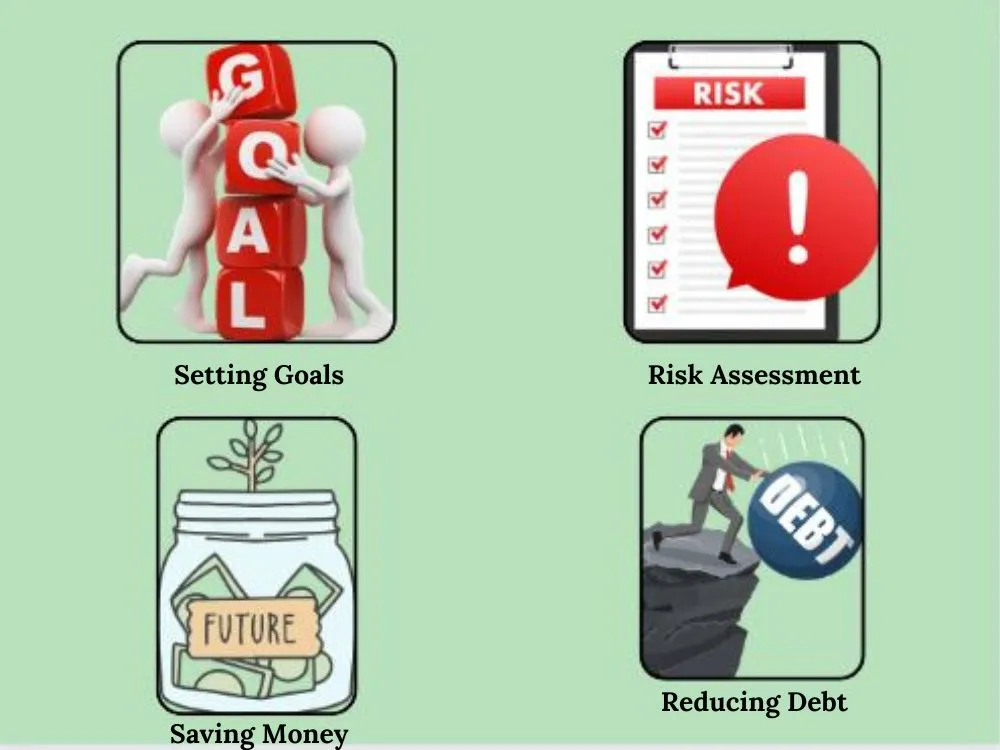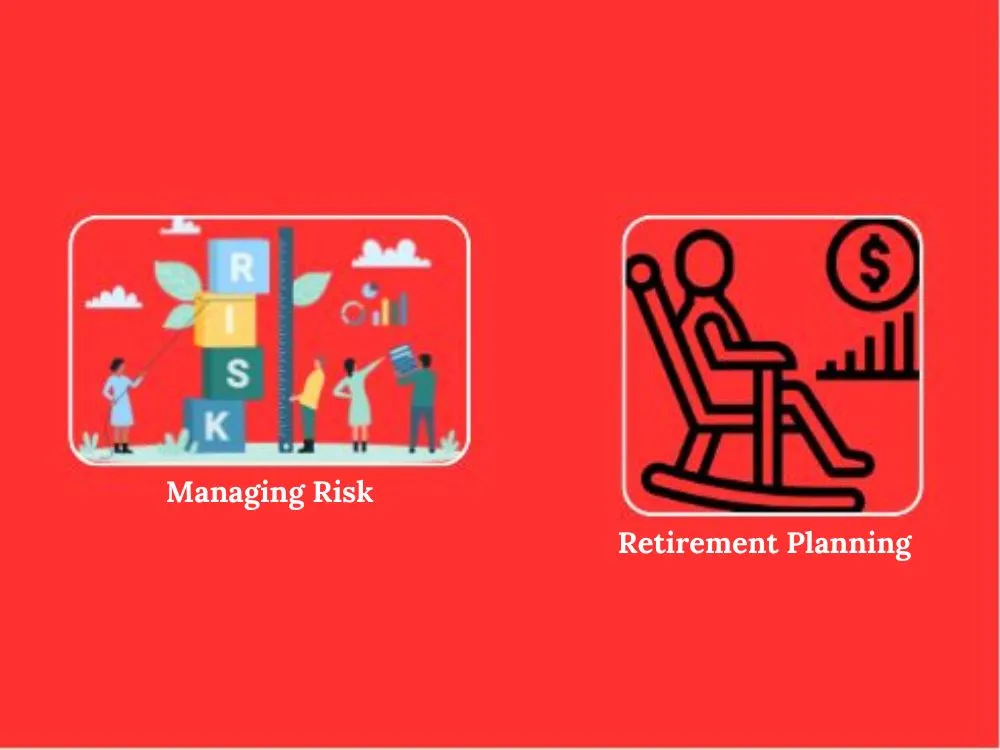.webp)
What is Investment Planning: A Comprehensive Guide
Have you ever thought about how some folks seem to easily grow their money while others struggle? That's where ‘Investment Planning’ steps in. It can be your ticket to financial peace of mind. Let's break it down in simple terms.
Investment planning is like giving your money a job, a smart job. It's not just about stashing cash under the mattress or in a piggy bank. It's about making your money hustle for you, so you can reach your dreams easily, whether it's about buying a home, sending your kids to college, or chilling on a beach when you retire.
Now, the cool part is the benefits. Just think about your money that can able to make little money babies over time. That's the magic of investment planning. It's a way to beat the rising cost of living, grow your wealth, and have more financial freedom.
In this guide, we are going to explain the secrets of investment planning without the boring stuff. Whether you are new to the investment industry or a professional looking for a tune-up, just stick with us as we explore the ins and outs of investment planning. Let's make your money work smarter, not harder. Ready to roll?
Key Elements of Investment Planning

A) Goal Setting and Risk Assessment
When it comes to growing your money, you need a better investment plan. That's where goal setting and risk assessment come into play in Investment Planning, think of them as your financial GPS.
Goal Setting: Imagine you are planning a road trip and you wouldn't just hit the gas without a destination in mind, right? The same goes for your money. Setting clear goals is like choosing your roadmap. Want to buy a house? Save for your kid's education? These are your destinations. We will walk you through how to set realistic goals that keep you on the right financial track.
Risk Assessment: Now, let's talk about risk, which is a crucial element in investment planning. Life is full of surprises, and some of them can mess with your money. That's why you need to assess the risks involved. It's not about being scared but it's about being smart. A risk assessment is a vital element in identifying potential risks and applying proper control measures that can save you from losing money.
So, proper investment planning always focuses on realistic goal setting and risk assessment. By having these duos, you can able to mitigate financial losses and achieve investment goals or targets.
B) Saving and Reducing Debt
Saving and reducing debt are two heavy hitters crucial in investment planning. If you want to supercharge your financial goals, then this duo is vital to be considered. Let’s dive into understanding these elements further:
Saving Money: Saving money doesn’t mean anything about being a Scrooge. It’s about avoiding unnecessary expenses and keeping the money for essential future needs. Saving helps you acquire the necessary funds and capital for investment. It protects you from obtaining loans or external debts. Saving money is necessary but it should be viable and shouldn’t compromise your essential needs.
Reducing Debts: Debts are a huge burden and they can make a person or company go broke. Obtaining unnecessary debts for fancy needs should be kicked to the curb. Debts mostly come with interest, which makes an extra layer of headache to the debtor. Sometimes, debts are inevitable in situations where you need immediate capital or emergencies. But overdoing the practice or making it usual is not advisable.
These two elements are super important in investment planning, where a person or company should consider saving money and say goodbye to obtaining debts.
Choosing the Right Investments

A) Asset Classes and Diversification
When it comes to choosing the right investment, there can be many asset classes such as equities (stocks), fixed-income securities (bonds), cash, marketable commodities, and real estate. Let’s break down everything further:
1. Equities (Stocks): Companies share their stocks for anyone to buy and gain ownership. When the company does well, so do you. It's like being a proud owner of a part of your favorite company. You can buy any amount of stocks and the profit or loss is determined according to that.
2. Fixed-Income Securities (Bonds): Bonds are like lending money and getting paid back with interest. It's a bit like being the banker in a game of Monopoly. Fixed-income securities generally pay a fixed amount of interest mostly in the form of coupons.
3. Cash: Cash is a reliable source of investment. It includes things like savings accounts and short-term investments. Cash investments are mostly short-term and pay back in the form of interest payments. Investors who are looking for a safe liquid investment can opt for this class.
4. Marketable Commodities: Marketable commodities are like goods you can touch, from gold to crude oil. Investing in these things is a bit like having a piece of the real world in your portfolio. It can also be categorized as hard commodities and soft commodities. Hard commodities are precious metals, crude oil, and related stuff. Soft commodities are agricultural products. You can choose your preferred commodity type to invest in.
5. Real Estate: Investing in real estate is like owning a piece of land on the earth. It could be residential, commercial, or even a slice of a trendy coffee shop down the street. It can be a long-term investment that brings good cash flow income and several other benefits.
The table below discusses the pros and cons of investing in these asset classes. Please scroll to the right to view all columns on smaller devices like mobile phones.
| Asset Class | Pros | Cons |
|---|---|---|
| Equities (Stocks) | * High Growth Potential: Stocks have the potential for high returns, especially if you pick the right companies. * Ownership Stake: Owning stocks means you own a piece of the company. * Liquidity: Stocks are usually easy to buy and sell. Thus, the liquidity of this investment is high.
| * Volatility: Prices can swing wildly which can lead to a potential short-term loss. * Market Risk: External factors like economic conditions can impact the stock prices * Research Needed: Successful stock investing often requires research and understanding of individual companies. |
| Fixed-Income Securities (Bonds) | * Stability: Bonds are generally safer than stocks that offer more stability. * Predictable Income: Bonds pay regular interest which provides a steady income stream. * Diversification: Bonds can balance the risk in a portfolio that includes stocks. | * Interest Rate Risk: Bond prices may fall if interest rates rise. * Inflation Risk: The fixed interest may not keep pace with inflation which can impact the real returns. * Credit Risk: There is a risk that the issuer may default on payments |
| Cash | * Safety: Cash is the most stable form of investment that provides capital preservation. No need to fear safety issues. * High Liquidity: Other than the least liquidity investments, cash has 100% liquidity which can be easily accessible for emergencies. * No Market Risk: No exposure to market fluctuations. It remains the same even in different market conditions | * Low Returns: Generally cash offers low returns compared to other least liquidity investments like real estate. * Inflation Erosion: Inflation can erode the purchasing power of cash over time. * Missed Growth Opportunities: With low returns, there is a potential to miss out on investment growth.
|
| Marketable Commodities | * Diversification: Commodities add diversity to a portfolio and may act as a hedge against inflation. * Tangible Assets: These are real tangible assets like gold or agricultural products. * Global Demand: Commodities often respond to global economic trends. | * Volatility: Prices of the commodities are highly volatile. * Storage Costs: Physical commodities need storage costs. * Market Complexity: Understanding the commodity markets requires some research and learning. |
| Real Estate | * Potential for Appreciation: In most cases, the values of real estate may increase over time. * Steady Income: Real estate investments offer steady income. Rental properties can provide a regular income stream. * Tangible Asset: Like commodities, real estate is a tangible asset. | * Illiquidity: Selling property takes time and may not be as straightforward as selling stocks. * Market Fluctuations: Real estate values are subject to market fluctuations. * Maintenance Costs: Property ownership involves maintenance expenses. |
B) Tax-Efficient Strategies
Even though taxes do not directly hit investment planning and decisions, the asset classes you choose and hold can determine the tax value. So, a careful evaluation and strategy implementation is necessary to lower the tax amounts. Here are some vital tax-efficient strategies that help amplify your financial efficiency:
- Tax-Advantaged Accounts: Consider these accounts as your financial allies. Contributions made to accounts like 401(k)s and IRAs often come with tax benefits. The money grows, shielded from immediate taxation allows you to build a strong financial portfolio while reducing your annual tax liability.
- Capital Gains and Losses: Investing inherently involves market fluctuations. Knowing when to strategically sell investments can make a significant difference. By understanding the capital gains and losses, you can easily optimize your tax position. Timing your sales tactfully helps minimize tax obligations and enhance your overall after-tax returns.
- Tax-loss Harvesting: This strategy involves turning market downturns into financial opportunities. When certain investments incur losses, strategically selling them will allow you to offset gains in other areas. Tax-loss harvesting is related to a financial rebalancing act that can help you maintain equilibrium in your investment portfolio while minimizing your tax bill.
- Asset Location: Think of your investments as guests at a well-organized party. Asset location involves placing the right investments in the right accounts to optimize tax efficiency. By aligning investments with the tax characteristics of specific accounts, you can able to minimize the impact of taxes on your overall returns.
Tips for Effective Investment Planning

A) Dollar-cost Averaging and Portfolio Strategies
Now, let's get into the basic and important facts of effective Investment Planning with some practical tips. We are talking about dollar-cost averaging and crafting a winning portfolio strategy. These are straightforward techniques to help you navigate the investment landscape with confidence.
- Dollar-cost Averaging: This means investing a fixed amount at regular intervals, regardless of market conditions. This strategy smoothens out the impact of market volatility and allows you to buy more shares when prices are low, and fewer shares when they are high. It's like surfing the waves of the market and steadily building your portfolio over time.
- Portfolio Construction: It is about building a balanced mix of assets like stocks and bonds that are tailored to your financial goals and risk tolerance. Diversifying your portfolio can minimize risk and enhance potential returns.
- Regular Portfolio Rebalancing: This means adjusting your investments periodically to maintain your desired asset mix. This strategic fine-tuning can ensure your portfolio stays aligned with your goals and adapts to market changes.
- Emergency Fund Essentials: Prioritize the creation of an emergency fund as a financial safety net. This helps cover unexpected expenses without disrupting your investment strategy. This fund provides stability and flexibility in times of unforeseen challenges.
B) Selecting the Right Accounts
Effective Investment Planning involves choosing the right accounts. It is a critical strategic move and match your account selection to align with your financial goals and optimize tax advantages. Employer-sponsored retirement accounts like 401(k)s offer tax benefits and often employer contributions, making them a solid choice for long-term retirement savings.
Moreover, Individual Retirement Accounts (IRAs) offer flexibility and additional tax advantages. Taxable brokerage accounts offer versatility and liquidity for goals like buying a home or other short-term objectives.
By understanding these unique features of each account type, you will be able to create a well-rounded and tax-efficient investment strategy that can be appropriate for your financial objectives.
Managing Risks and Preparing for Retirement

A) Risk Mitigation and Diversification
Risk mitigation and diversification are two essential strategies that stand out in investment planning. Risk mitigation is all about identifying the potential threats to the investments and applying proper measures to mitigate them.
This includes the diversification of investment across different asset classes. Diversification is simply putting investments in different categories and avoiding putting all eggs in the same basket. By not putting all your investments in one place, you can reduce the impact of a poor-performing asset on your overall portfolio.
These twin strategies work hand-in-hand and provide a safety net that can shield your investments from undue volatility, market fluctuations, and any other impacts. For example, if you have invested in real estate and stocks, and you see the market condition of real estate is in recession. In this situation, you still obtain benefits from the stocks without going broke.
If you put all your investments in the same real estate basket then you may experience a huge loss. This is why diversification of investment in different asset classes is necessary.
B) Retirement Account Options
If you plan to go on retirement, the choices among various retirement accounts become vital. Employer-sponsored plans, like 401(k)s or 403(b)s can bring the advantages of employer contributions and tax benefits. Plus, they serve as strong tools for long-term savings.
Individual Retirement Accounts (IRAs) also offer flexibility which enables contributions even without employer plans. Roth IRAs promise tax-free withdrawals in retirement, while Traditional IRAs may offer tax deductions on contributions.
It is essential to choose retirement accounts wisely, as the options which is crucial for ensuring a comfortable and financially reliable retirement.
Practical Tips and Resources for Investment Planning

A) Utilizing Tools and Advisors
Several tools are available to simplify investment planning. Plus, you can get ideas from financial advisors. Blending the personal touch of advisors with the efficiency of digital tools is a game-changer. Here's how you can seamlessly integrate both:
Digital Tools:
- Budgeting Apps: Keep tabs on your spending and savings effortlessly.
- Investment Calculators: Get a quick glimpse of potential returns and risks.
- Portfolio Trackers: Stay in the know about your investments in real time.
Financial Advisors:
- Personalized Insights: Advisors offer relevant advice based on your unique financial situation.
- Customized Plans: Craft an investment strategy that aligns with your goals and risk tolerance.
- Navigating Complexity: Advisors guide in complex financial scenarios.
By tapping into the insights of financial advisors and leveraging the convenience of digital tools, you can create a powerful investment planning strategy.
B) Case Study Example for Investment Planning
Sarah is a 35-year-old Digital marketing professional based in the United States, who embarked on her investment journey to secure a comfortable retirement. Here's a snapshot of her case study:
Financial Snapshot:
- Annual Income: $80,000
- Savings at Start: $20,000
- Monthly Investment Budget: $500
Goals:
- Short-Term: Save for a down payment for a home purchase in the next 5 years.
- Mid-Term: Fund her children's education approximately in 15 years.
- Long-Term: Build a strong retirement fund for financial independence.
Investment Strategy:
- Diversification: Spread investments across a mix of stocks and bonds.
- Tax-Efficiency: Maximize contributions to a 401(k) for tax advantages.
- Emergency Fund: Maintain a liquid emergency fund equivalent to six months of living expenses.
Utilizing Tools and Advisors:
- Digital Tools: Employed budgeting apps and investment calculators to track progress.
- Financial Advisor: Collaborated with a certified financial planner for personalized guidance on long-term investment strategies.
Results:
- Successfully accumulated a down payment for a home in 5 years.
- Funded children's education with returns from a well-balanced investment portfolio.
- On track to achieve a comfortable retirement with continuous monitoring and adjustments guided by the financial advisor.
Sarah's case study exemplifies the tangible benefits of a strategic investment plan. This incorporates diversification, tax efficiency, and a personalized approach. It showcases how a well-informed, goal-oriented strategy, supported by digital tools and expert advice, can pave the way for financial success.
Final Thoughts
Investment planning is a key strategy to get the most out of your money. Whether it can be a short-term, mid-term, or long-term goal, a straightforward and purpose-driven approach helps achieve it. There may be risks in investments where a diversified approach can help mitigate the risk potential.
It is advisable to avoid putting all oranges in the same basket. Trying different asset classes for investment is a good approach (also called investment diversification). Risk Management is an important part of investment planning, where it identifies the risk potential.
When it comes to taxes, be strategic. Take advantage of accounts and plans that minimize what you owe and allow you to keep more of your money for what matters most to you. Remember, your Investment planning journey is unique to you. Craft a roadmap that fits your goals, make informed decisions, and commit to the long term.
FAQs
Q1: What is the meaning of investment planning?
Investment planning is like strategically allocating your funds to various assets to make them work for you. This helps you achieve financial goals like buying a home, funding education or securing a comfortable retirement.
Q2: What is the main objective of investment planning?
The main objective of investment planning is to make your money grow over time. You can choose wisely where to invest and beat the rising cost of living, build wealth, and attain financial freedom, which allows you to realize your dreams and aspirations.
Q3: What are the features of investment planning?
Investment planning involves goal setting, risk assessment, saving, and reducing debt. It's about setting clear financial goals, understanding and managing risks, saving money for future needs or emergencies, and clearing unnecessary debts. These features form the foundation for a good investment strategy.
Q4: What are the key asset classes in choosing the right investments?
Asset classes include equities (stocks), fixed-income securities (bonds), cash, marketable commodities, and real estate. Each class has its unique characteristics that offer investors a variety of options to diversify their portfolios.
Explore Related Posts
https://smarttoolsai.com/post/high-risk-merchant-account-at-highriskpay-com
https://smarttoolsai.com/post/shaping-the-future-of-finance-how-ai-is-revolutionizing-the-industry
.webp)